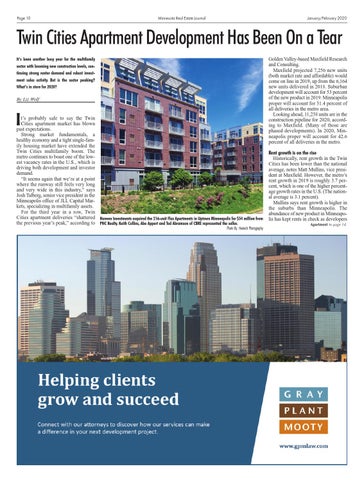Page 10
Minnesota Real Estate Journal
January/February 2020
Twin Cities Apartment Development Has Been On a Tear It’s been another busy year for the multifamily sector with booming new construction levels, continuing strong renter demand and robust investment sales activity. But is the sector peaking? What’s in store for 2020?
By Liz Wolf
I
t’s probably safe to say the Twin Cities apartment market has blown past expectations. Strong market fundamentals, a healthy economy and a tight single-family housing market have extended the Twin Cities multifamily boom. The metro continues to boast one of the lowest vacancy rates in the U.S., which is driving both development and investor demand. “It seems again that we’re at a point where the runway still feels very long and very wide in this industry,” says Josh Talberg, senior vice president in the Minneapolis office of JLL Capital Markets, specializing in multifamily assets. For the third year in a row, Twin Cities apartment deliveries “shattered Nuveen Investments acquired the 216-unit Flux Apartments in Uptown Minneapolis for $54 million from the previous year’s peak,” according to PNC Realty. Keith Collins, Abe Appert and Ted Abramson of CBRE represented the seller. Photo By Heinrich Photography
Golden Valley-based Maxfield Research and Consulting. Maxfield projected 7,256 new units (both market rate and affordable) would come on line in 2019, up from the 6,164 new units delivered in 2018. Suburban development will account for 53 percent of the new product in 2019. Minneapolis proper will account for 31.4 percent of all deliveries in the metro area. Looking ahead, 11,238 units are in the construction pipeline for 2020, according to Maxfield. (Many of those are phased developments). In 2020, Minneapolis proper will account for 42.6 percent of all deliveries in the metro.
Rent growth is on the rise Historically, rent growth in the Twin Cities has been lower than the national average, notes Matt Mullins, vice president at Maxfield. However, the metro’s rent growth in 2019 is roughly 3.7 percent, which is one of the higher percentage growth rates in the U.S. (The national average is 3.1 percent). Mullins says rent growth is higher in the suburbs than Minneapolis. The abundance of new product in Minneapolis has kept rents in check as developers Apartment to page 14




